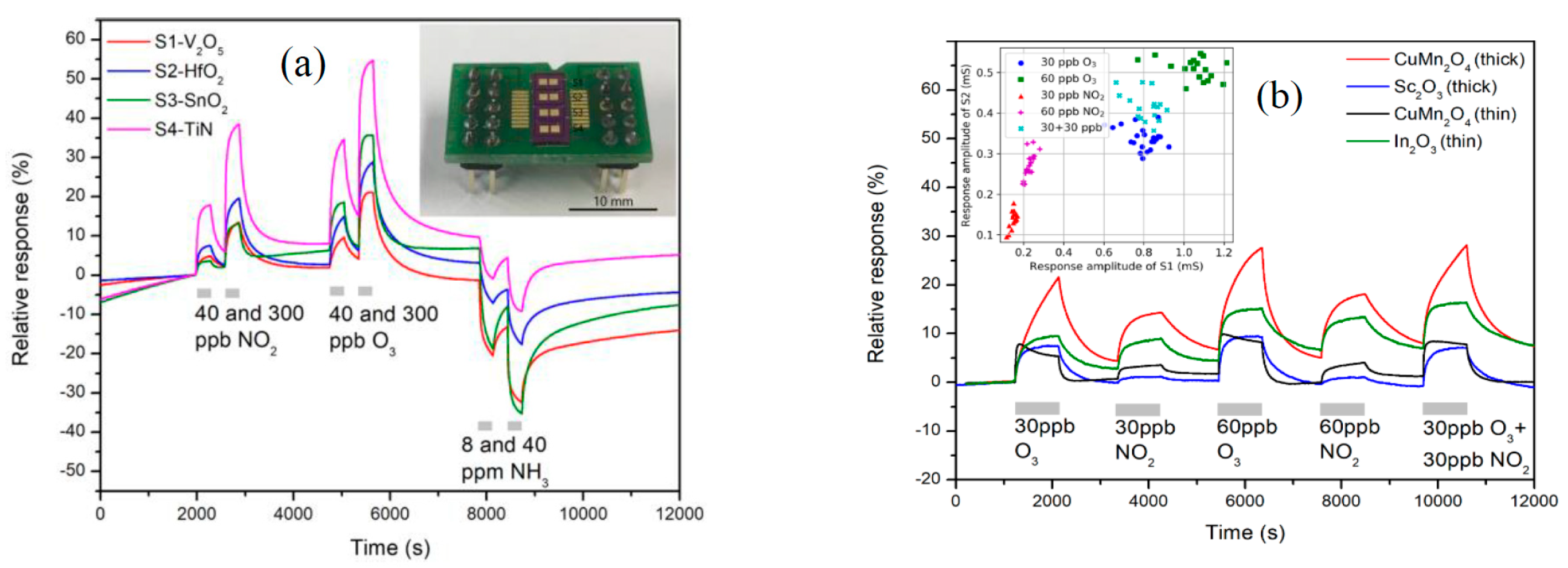Selective Detection of Toxic Gases by Arrays of Single-Layer Graphene Sensors Functionalized with Nanolayers of Different Oxides †
Abstract
1. Introduction
2. Materials and Methods
3. Discussion
Author Contributions
Funding
Institutional Review Board Statement
Informed Consent Statement
Data Availability Statement
Acknowledgments
Conflicts of Interest
References
- Kodu, M.; Berholts, A.; Kahro, T.; Eriksson, J.; Yakimova, R.; Avarmaa, T.; Renge, I.; Alles, H.; Jaaniso, R. Graphene-Based Ammonia Sensors Functionalised with Sub-Monolayer V2O5: A Comparative Study of Chemical Vapour Deposited and Epitaxial Graphene. Sensors 2018, 19, 951. [Google Scholar] [CrossRef] [PubMed]
- Lind, M.; Kiisk, V.; Kodu, M.; Kahro, T.; Renge, I.; Avarmaa, T.; Makaram, P.; Zurutuza, A.; Jaaniso, R. Semiquantitative Classification of Two Oxidizing Gases with Graphene-Based Gas Sensors. Chemosensors 2022, 10, 68. [Google Scholar] [CrossRef]

Disclaimer/Publisher’s Note: The statements, opinions and data contained in all publications are solely those of the individual author(s) and contributor(s) and not of MDPI and/or the editor(s). MDPI and/or the editor(s) disclaim responsibility for any injury to people or property resulting from any ideas, methods, instructions or products referred to in the content. |
© 2024 by the authors. Licensee MDPI, Basel, Switzerland. This article is an open access article distributed under the terms and conditions of the Creative Commons Attribution (CC BY) license (https://creativecommons.org/licenses/by/4.0/).
Share and Cite
Kodu, M.; Lind, M.; Kiisk, V.; Renge, I.; Jaaniso, R. Selective Detection of Toxic Gases by Arrays of Single-Layer Graphene Sensors Functionalized with Nanolayers of Different Oxides. Proceedings 2024, 97, 165. https://doi.org/10.3390/proceedings2024097165
Kodu M, Lind M, Kiisk V, Renge I, Jaaniso R. Selective Detection of Toxic Gases by Arrays of Single-Layer Graphene Sensors Functionalized with Nanolayers of Different Oxides. Proceedings. 2024; 97(1):165. https://doi.org/10.3390/proceedings2024097165
Chicago/Turabian StyleKodu, Margus, Martin Lind, Valter Kiisk, Indrek Renge, and Raivo Jaaniso. 2024. "Selective Detection of Toxic Gases by Arrays of Single-Layer Graphene Sensors Functionalized with Nanolayers of Different Oxides" Proceedings 97, no. 1: 165. https://doi.org/10.3390/proceedings2024097165
APA StyleKodu, M., Lind, M., Kiisk, V., Renge, I., & Jaaniso, R. (2024). Selective Detection of Toxic Gases by Arrays of Single-Layer Graphene Sensors Functionalized with Nanolayers of Different Oxides. Proceedings, 97(1), 165. https://doi.org/10.3390/proceedings2024097165





